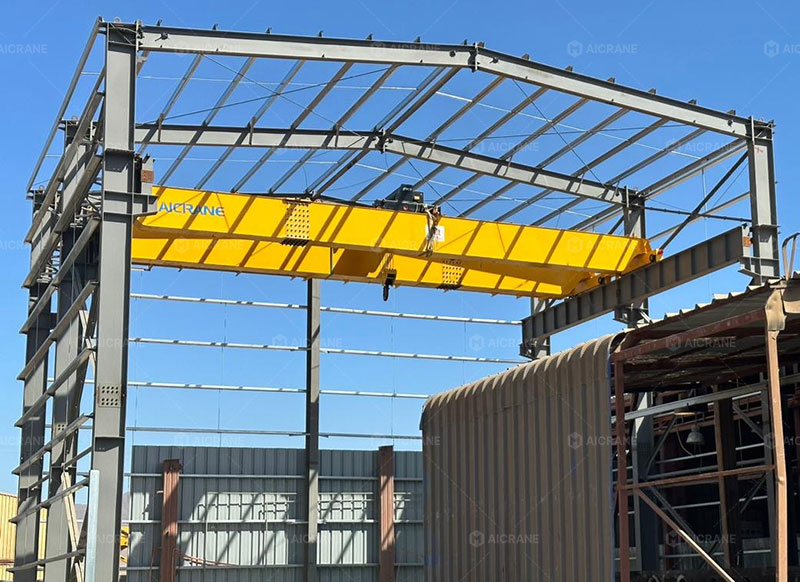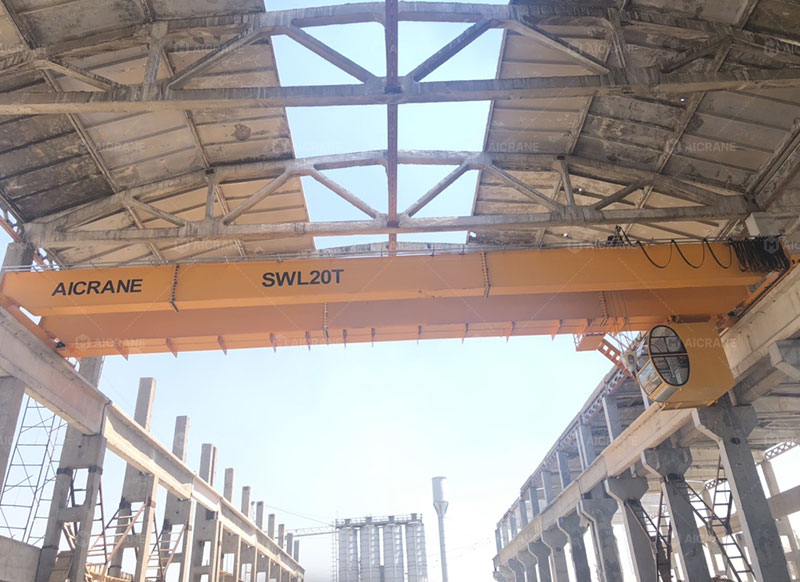Double girder overhead cranes are widely used in heavy-duty industrial applications, offering higher load capacity, greater lifting height, and more stability than their single girder counterparts. However, to ensure safe, efficient, and cost-effective operation, the clearance and building requirements for these cranes must be carefully considered during both the planning and design phases. This article explores the key building and clearance parameters you need to know when planning for a double girder overhead crane.

1. Introduction to Double Girder Overhead Cranes
A double girder overhead crane consists of two parallel bridge girders supported on end trucks that travel along a runway. The hoist and trolley run on rails mounted on top of the bridge girders. These cranes are ideal for high-capacity lifting (typically from 10 tons to over 500 tons), long spans, and heavy industrial environments like steel mills, shipyards, manufacturing plants, and warehouses.
Due to their size and operational demands, double girder overhead cranes impose specific requirements on the building structure in terms of clearance, runway support, access, and integration with other systems.
2. Key Clearance Parameters for Double Girder Cranes
2.1 Top Clearance (Headroom)
Top clearance refers to the vertical distance from the lowest point of the building structure (roof truss, beam, or ceiling) to the highest point of the crane (typically the trolley or motor).
-
Why it matters: Insufficient headroom can limit crane operation, prevent full lifting height utilization, or even cause collisions.
-
Typical allowance: At least 1 meter (3.3 ft) is often recommended between the top of the crane and the building roof structure.
-
Design consideration: Compact hoist and trolley designs can reduce headroom requirements.
2.2 Hook Approach (End Clearance)
Hook approach is the minimum distance between the center of the hook and the nearest wall or obstruction at either end of the crane’s runway.
-
Why it matters: A smaller hook approach maximizes the usable area beneath the crane.
-
Typical values: For double girder eot cranes, the end hook approach can be around 1 to 1.5 meters depending on the trolley size.
-
Design tip: Custom end carriages or optimized trolley designs can reduce hook approach distances.
2.3 Side Clearance
Side clearance is the horizontal distance between the moving components (like the hoist trolley or bridge girders) and building columns, walls, or obstructions.
-
Why it matters: Inadequate side clearance can hinder movement or increase wear due to repeated close passes.
-
Recommended space: Maintain at least 0.5 to 1 meter (1.6 to 3.3 ft) on each side of the crane’s path.

2.4 Under-Bridge Clearance (Lifting Height)
This refers to the vertical distance between the floor and the hook when it is in the highest position.
-
Why it matters: It defines how high loads can be lifted, which is crucial for tall or bulky items.
-
Design flexibility: With double girder cranes, the hoist is mounted on top of the girders, offering greater lifting height than single girder crane types.
3. Building Requirements for Double Girder Overhead Cranes
3.1 Structural Load Capacity
The building structure, including columns and runways, must be designed to handle the vertical and horizontal loads imposed by the crane and the load being lifted.
-
Vertical loads include the weight of the crane, trolley, hoist, and the lifted load.
-
Horizontal loads result from acceleration, deceleration, wind loads, or side pulling.
Tip: Engage a structural engineer to verify or design the building framework to safely carry these loads.
3.2 Runway Beam and Rail System
The crane travels on runway beams which are mounted on brackets or corbels connected to building columns. These beams must be precisely aligned and adequately supported.
-
Runway beam material: Typically fabricated steel I-beams or box girders.
-
Rail type: Rails (like P43, QU70, etc.) are welded or clipped on top of the runway beam.
-
Tolerances: Alignment and level tolerances are tight – commonly ±1 mm/m over the span to prevent wheel wear or derailment.
3.3 Runway Column Design
The columns that support the runway girders must be designed to resist:
-
Vertical reactions from crane wheel loads
-
Horizontal thrusts due to crane travel
-
Potential seismic and wind loads (especially for outdoor applications)
Heavier loads or long spans may require independent gantry columns separate from the main building frame.
3.4 Access Platforms and Maintenance Space
Proper access to the crane and runway area is essential for safe inspection, maintenance, and emergency access.
-
Walkways: Required on one or both girders for maintenance staff.
-
Service platforms: May be installed for access to motor, gearbox, or control panels.
-
Clearance: Allow sufficient width for personnel to safely walk and perform maintenance.
3.5 Electrical Clearance and Cable Routing
Crane power supply and control cables (festoon systems, conductor bars, or cable reels) require space to be safely installed and maintained.
-
Minimum clearance: Maintain at least 200-300 mm between cable systems and building structures.
-
Cable trays and brackets: Should be properly designed to avoid interference and minimize wear.
4. Special Considerations
4.1 Seismic Zones
In earthquake-prone areas, building and crane structures must be designed according to seismic codes (e.g., ASCE 7, Eurocode 8). This may include special anchorage, reinforcement, and damping systems.
4.2 Integration with HVAC, Lighting, and Fire Systems
Double girder cranes typically operate in shared spaces with lighting, HVAC ducts, sprinklers, etc.
-
Plan routing of these systems to avoid interference with crane travel.
-
Maintain fire clearance as per local codes (e.g., NFPA 13 for sprinklers).
4.3 Outdoor or Harsh Environment Requirements
If the crane is installed in an outdoor or aggressive environment (e.g., foundry, marine, chemical plants):
-
Building structures and coatings should be corrosion-resistant.
-
Additional clearance may be required to accommodate weatherproof enclosures or covers on the crane.
5. Conclusion
A double girder overhead crane is a major investment that significantly boosts material handling efficiency, but it also demands precise planning for clearance and building integration. Ignoring these requirements can lead to costly redesigns, operational inefficiencies, or even structural safety hazards.
By considering critical aspects like headroom, hook approach, structural load capacity, runway beam design, and space for maintenance, you ensure that the crane not only fits your facility but also operates safely and efficiently for years to come.
Whether you’re upgrading an existing facility or constructing a new one, work closely with overhead crane suppliers, structural engineers, and architects early in the design process to get your specifications right.
